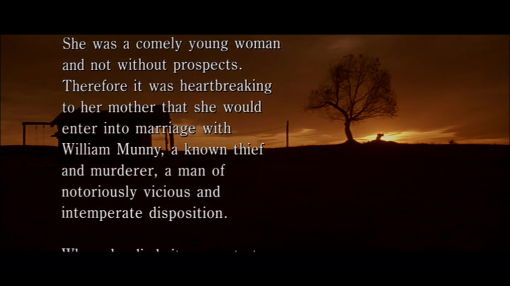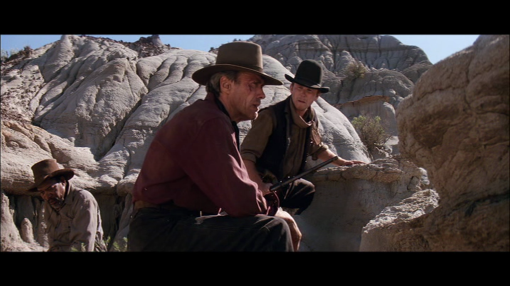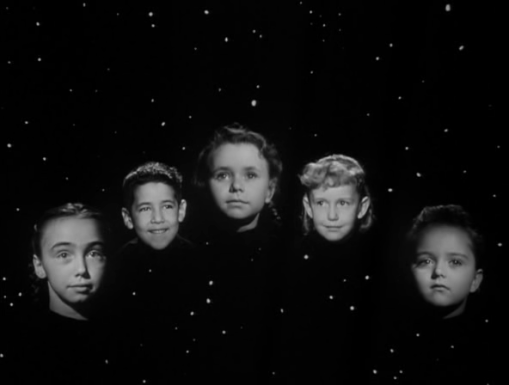
The first shot. The quaintly phrased "background" implies that a legend is about to be told.
131 min. WB/Malpaso Productions. Directed and produced by Clint Eastwood. Screenplay by David Webb Peoples. Starring Clint Eastwood, Gene Hackman, Morgan Freeman and Jaimz Woolvett.
Amazon DVD – Blu-Ray.
– Blu-Ray.
Synopsis
The action is set in motion with a scene of a drunken cowboy attacking a prostitute in a small town “billiards hall.” The female staff of a small town brothel, disgusted by the objectifying response of the Sherrif (Gene Hackman), offer a $1000 bounty for whoever kills the cowboy and his accomplice. William Munny (Clint Eastwood), a reformed and retired superkiller, is tempted to get back in the game by a young and vindictive “assassin” (Jaimz Woolvett). He eventually agrees to go and brings his friend Ned (Morgan Freeman) along. The film follows uses the cover of their vendetta to uncover subtleties about each of their characters and ultimately, to make some serious statements about violence and justice.
Commentary
This film is clearly steeped in “old Eastwood” folklore. In it, he reprises the quintessential Clint Eastwood character. Cool and removed, he violently dominates all the other characters. He’s not a particularly good person, but everyone else is really bad. That would apply to The Good, the Bad and the Ugly(1965, dir. Sergio Leone) and Dirty Harry(1971, dir. Don Siegel) to name only his most famous roles. Though he never sunk to playing just a tough-guy gunman and he always added just enough humor to keep you guessing what he was really thinking, Unforgiven is different. He doesn’t just play the role of the tough-guy, he destroys it.
The film opens with a legendary type of scene: a few lines in 19th century American style describing Munny’s dead wife. The lack of detail and storybook tone of the prose clearly evoke events that are not quite natural. Munny is introduced to us not as a man but as a legend; a myth. What is he? I think that most basically he is violence. Not some notion of necessary violence in the world but the perpetuation of violence that man cause with his actions. Unforgiven offers no way to break that cycle, it just follows it through to its bitter end. This is what happens in a world created by three decades of Clint Eastwood movies.
What Eastwood did with Unforgiven, to retrace the implications of his former self to their painful conclusions, bears a striking resemblance to the “American” comeback of Johnny Cash. In 1994, Johnny Cash began his series of “American Recordings” with Rick Rubin. Cash (or Rubin, as the case may be) capitalized on the classic myth of “The Man in Black” in order to reexamine the foundations upon which that myth was founded. They ended up producing five of the best albums of Cash’s long and illustrious career. In them, Cash dealt with the long term consequences of being a star of his stature–the drugs, the degradation and his ultimate salvation. Beyond just the usual “it’s so hard to be famous” routine, Cash speaks about regret for the life that he lived, the pain that he caused people and describes the real solace that he found in his wife and the salvation that he found in Jesus. He didn’t change his symbolic language but by reexamining himself with new eyes he uncovered the sadness and pain that were always festering behind his stiff virile persona.

The campfire fulfils its traditional role of catalyzing cathartic and terse man-to-man conversatioins
Eastwood forges a similar path. William Munny was once all the nasty sides of ‘The Man with No Name,’ ‘Dirty Harry’ and ‘Josey Wales’ all rolled up in one. But he’s left that, or so he thinks. He’s been saved by his late wife. Now he’s a man of peace, counting hogs and raising his children. But, as is shown time and again, he is haunted by his past. The dozens of men that he killed visit him in visions and nightmares and when given the encouragement, he sets out on a violent mission again. Significantly, when trying to convince Ned to join him, he exaggerates the wrong that requires their revenge. He adds on a few more violent touches (cut off her ears, other parts of the body) in an almost pathetic attempt to make his violent nature coincide with justice. He’s lying to himself and he knows it–once The Kid kills the last cowboy and tries to justify it as “he had it coming,” Munny replies (in the most quoted line of the film) “We all have it coming.”
The pretense of justice as a cover for pure violence is revisited with the character of Sherriff ‘Little Bill’ Daggett. Daggett is clearly the villain in the film even though it’s clear that he not only abuses his role as sheriff, he actually provides justice for Big Whiskey. Without him, even more violence and injustice would reign. But his behavior is unpardonable. It’s clear that he’s driven first by sadism and only secondly by any sense of justice. Even worse, he doesn’t realize the monster that he’s become. In the final showdown he begs for his life, saying “I don’t deserve to die like this, I was Little Bill…” But Munny understands what he was and who he is. “Deserves’s got nothing to do with it,” he responds–the glory of violence is nothing but an illusion.
One the most telling scenes in Unforgiven is also seems to be one of its most uneventful. After deciding to go after the “whores’ gold,” Munny tries to get back in to shape. He tries to hit some cans with a handgun from a few yards away and misses time after time. Not only is a scene like this almost unavoidable in a Western, it is inescapably similar to a scene in Eastwood’s earlier The Outlaw Josey Wales (1976). In that film, he plays a farmer who is out for revenge from the hooligans who raped and killed his wife. Out of necessity, Josey Wales consciously assumes the role of the murderer in order to set things right; he becomes an outlaw. William Munny can’t. Josey Wales quickly develops (or regains) the preternatural marksmanship that defines any Western hero. (You can watch that scene here.) But William Munny, the most feared killer in all the land, can’t manage the most basic exercise of shooting cans off a fence.
Munny isn’t a character, he’s a force of nature. He’s not meant to be “real,” in any classical sort of sense. That’s established by the legend-like intro and coda. Throughout the film he refuses to become the persona that he “should be” according to Western logic. He doesn’t talk like a killer, ride like a killer or drink like a killer because he’s not a killer–he’s death itself. In an interview quoted in John Saunders’ passable book The Western Genre: From Lordsburg to Big Whiskey , Eastwood said that the film was about ‘repercussions.’
The cowboys whose childish cruelty begins the film aren’t evil. But they must suffer consequences. “The Englishman,” Bill the Sheriff, Ned–they all suffer the repercussions of their actions. Not because any of them are particularly good or bad but because all actions have consequences. The only one who never pays the final price is William Munny. Is that because the unending torment of living is worse than death for him? Perhaps. Or is he superhuman, in some sense?

Though most of the film takes place in poorly lit houses and at night, we are reminded of the frontier with vistas like these.
The Western is always characterized by being set on the frontier, on the border between civilization and the wild. The ensuing anarchic culture has proven itself to be quite amenable to the film medium. Depending on the approach of the author or director, this is used in different ways. In the old fashioned Westerns, it was to amplify the presence of the hero. In the more subtle Westerns, like Eastwood’s other classics and The Searchers (1956, dir, John Ford), the frontier and its lawlessness unmask the parts of human nature that are perforce covered in more developed societies. Only in such a setting could Ford confront racism so directly. Kurosawa gave a similar reason for choosing to set many of his films in the pre-Tokugawa period of the “warring states:” human nature is more visible when society has subsided. But this is the last Western. This is the end of the line. There’s something lethal in Munny’s character–not just for his enemies but for the mystique of the West itself. You can see more about human nature when society isn’t as strict but what you see is devastating.
Saunders also points out the conspicuous lack of the definite article in the title. Who isn’t forgiven?The cowboys? The whores? The sheriff? The Kid? Ned? Munny? A plausible case could be made for any one of them. There are no winners this time and the losers have no glory. This is the ugly side of the West, the inescapable repercussions of violence.

The most devastating scene in the film. The ambivalent assassins must suffer the dying cries of the essentially innocent young cowboy.





